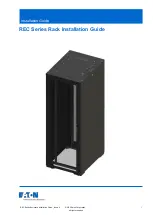
SATA II RAID Subsystem
16
User Manual
1.3 SCSI Concepts
Before configuring the subsystem, you must first understand some basic SCSI
concepts so that the subsystem and SCSI devices will function properly.
1.3.1 Multiple SCSI Format Support
The subsystem support the SCSI interface standards listed below. Note that the data
bit and cable length restrictions must be followed.
SCSI Type
Data Bit
Data Rate
Cable
SCSI-1
8 Bits
5 MB/Sec
6 m
Fast SCSI
8 Bits
10 MB/Sec
3 m
Fast Wide SCSI
16 Bits
20 MB/Sec
3 m
Ultra SCSI
8 Bits
20 MB/Sec
1.5 m
Ultra Wide SCSI
16 Bits
40 MB/Sec
1.5 m
Ultra 2 SCSI
8 Bits
40 MB/Sec
12 m
Ultra 2 Wide
16 Bits
80 MB/Sec
12 m
Ultra 160 Wide
16 Bits
160MB/Se
12 m
Ultra 320 LVD
16 Bits
320MB/Se
12 m
1.3.2 Host SCSI ID Selection
A SCSI ID is an identifier assigned to SCSI devices which enables them to
communicate with a computer when they are attached to a host adapter via the
SCSI bus. Each SCSI device, and the host adapter itself, must have a SCSI ID
number (Ultra 320 Wide SCSI = 0 to 15). The ID defines each SCSI device on the
SCSI bus. If there are more than one SCSI adapter in the Host subsystem, each
adapter forms a separate SCSI bus. SCSI IDs can be re-used as long as the ID
is assigned to a device on a separate SCSI bus. Refer to the documentation
that came with your peripheral device to determine the ID and how to change it.
The subsystem must be assigned a unique SCSI ID ranging from 0 to 15 for the
Ultra 320 LVD SCSI host system. The default value is ID 0.
Summary of Contents for iS12U3
Page 1: ...SATA II RAID Subsystem User Manual Revision 1 0...
Page 37: ...SATA II RAID Subsystem User Manual 37...
Page 38: ...SATA II RAID Subsystem 38 User Manual...
Page 39: ...SATA II RAID Subsystem User Manual 39...
Page 40: ...SATA II RAID Subsystem 40 User Manual...
















































